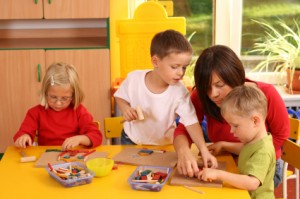By Shnieka Johnson, museum educator, curriculum designer and independent consultant specializing in museums and schools
Helping your child explore their inner artist is one of the best things a parent can provide, and it does not require a field  trip or an expensive class. Crafting and making art at home can be just as enjoyable and educational. There are so many options when it comes to supplies and classes that are offered to families with children for art making. There are aisles and aisles of supplies, papers, paints and other tools.
trip or an expensive class. Crafting and making art at home can be just as enjoyable and educational. There are so many options when it comes to supplies and classes that are offered to families with children for art making. There are aisles and aisles of supplies, papers, paints and other tools.
Art making can be a stand-alone project or a follow-up to an activity or experience that you have had as a family. In addition to showcasing their creativity, art making is a great way for children to share a reaction or express their feelings.
Here are a few ideas:
Clay
A fun way for children to be tactile is to give them clay for exploration. The ability to mold and shape an object and then change it again and again can be very entertaining for a child. Just be sure to keep the clay is in a cool moist environment for maximum use.
When using clay, talk to you child about what he or she is making. Is it an object, an animal or food? Remember to take a digital photo to remember the sculptures that your child created.
Collage
A collage can be a fun activity and as simple or as intricate as you desire. You can use paper or fabric and have a structured or free form collage. All you need is a background, scrap materials and a glue stick.
Free form collage has no definite shape and can be torn paper to cut paper. Structured collage is made to mimic a recognizable image and again can be either torn paper or cut paper. However, fabrics and foils are great for collage making too.
Painting
Paint projects in particular are the most anxiety ridden. However, if you start small you can have great possibility. No need to start with a large palette of paints. Just think — mixing a combination of just three can create any color.
Yes, the primary colors—blue, red and yellow. Take white paper, a brush and three paints, and begin discovering color mixing with your child. Help your child understand and the color combinations (and for younger children, identifying each color), and t then take it a step further and begin adding white and black paint. Allow your child time to explore each of the color combinations and ask her questions to further her understanding. How do the colors change when mixed together? How do you make the color lighter? Darker?
Sketching
For sketching, all you need is a pencil and paper. By taking a walk and observing your surroundings or looking through photos from a recent family trip, your child will be able to find great motivation for sketching. Depending on your child’s age, she may have just as much fun tracing different objects on paper. Sketching, in any form, can be a very soothing activity.
Depending on the child’s age, the type of material that you use can vary. You can use, pencils, colored pencils or even chalks. Whether you use regular paper or sketchpad will also depend on your child’s age. Older children will enjoy sketching on watercolor paper and then completing their works with paint.
When working with your children at home, exploration is key. Have a designated space, age appropriate materials and patience. Yes, you are taking a risk of making a mess—but that’s part of the fun.
Happy crafting!



